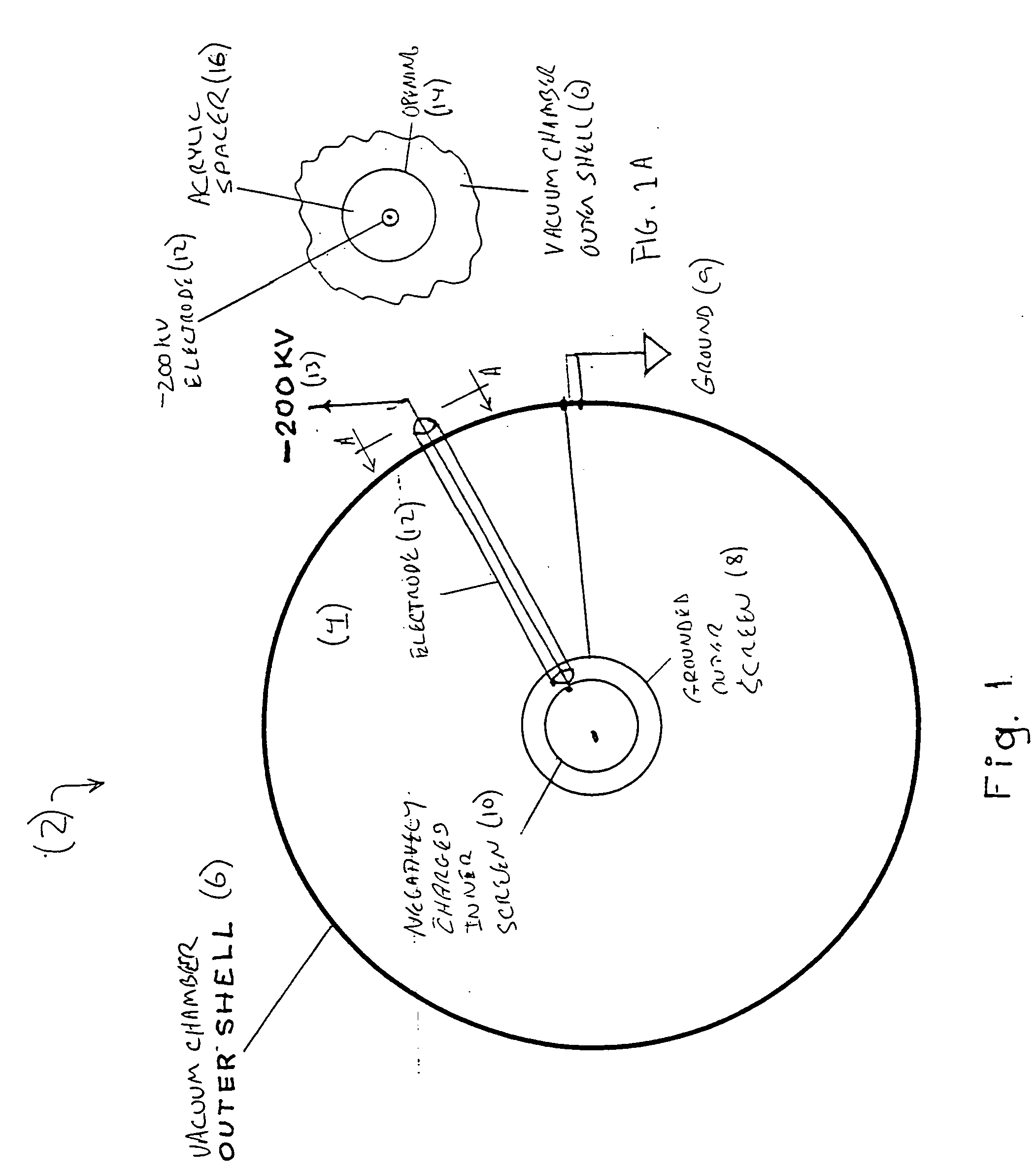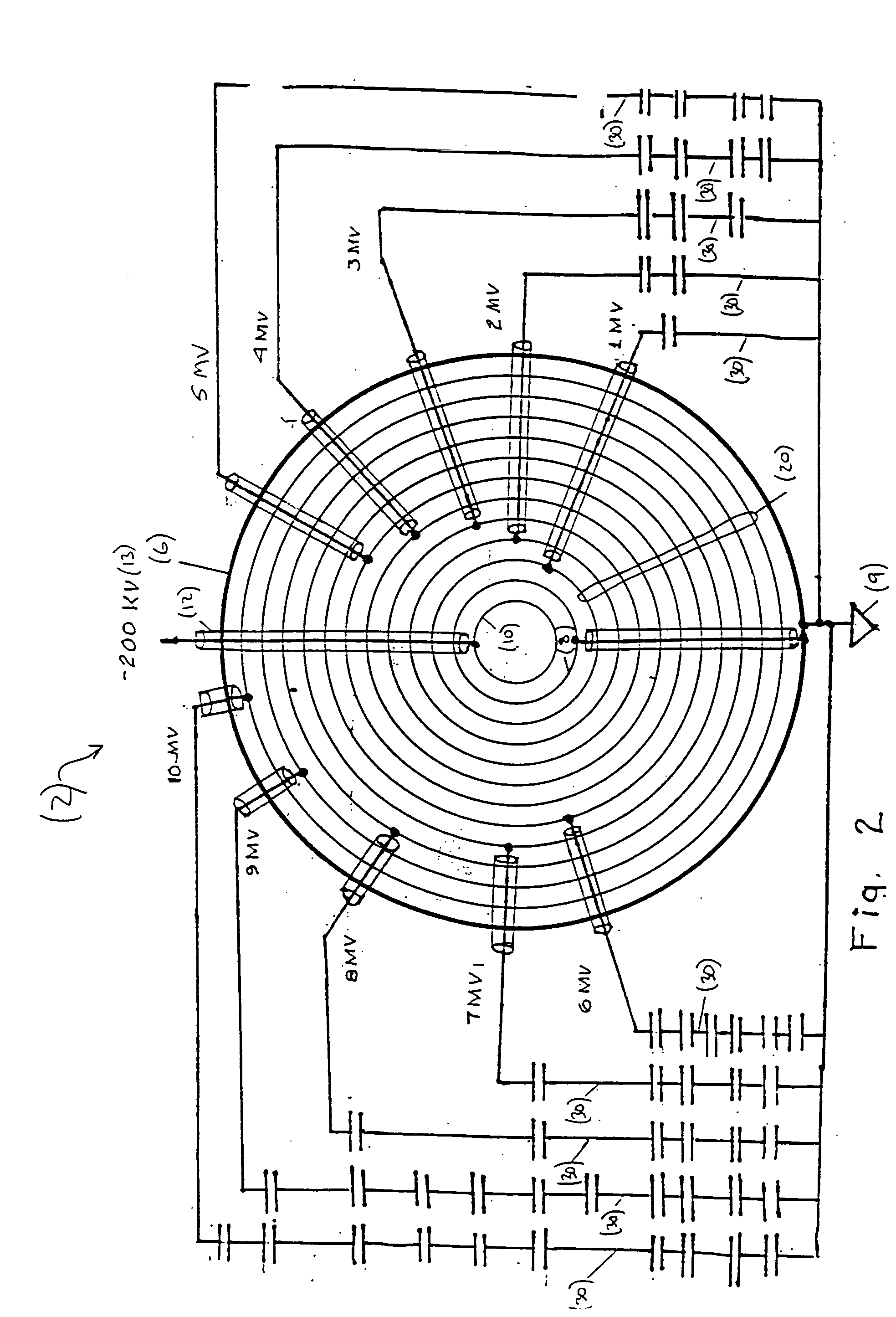3He reactor with direct electrical conversion
a helium3 and fusion reactor technology, applied in nuclear reactors, nuclear engineering, greenhouse gas reduction, etc., can solve the problems of not being able to produce a controlled, sustainable nuclear fusion reaction, and having no place to put toxic residues of present nuclear fission reactors, etc., to suppress any sparking and long air leakage path
- Summary
- Abstract
- Description
- Claims
- Application Information
AI Technical Summary
Benefits of technology
Problems solved by technology
Method used
Image
Examples
first embodiment
Conventional Electrostatic Fusion Reactor Design
[0031] Based on the voltage-pressure dependent electrical arcing characteristics discussed above, the first inventive embodiment calls for a relatively large reactor (e.g., a vacuum chamber diameter of at least about 3 ft.), and a feed electrode passing through the vacuum chamber with a large space gap so as to provide a long air leakage path sufficient to suppress any sparking when carrying high voltages (e.g., −200 kV). In particular, as shown in FIGS. 1 and 1A, the 3He fusion reactor (2) includes a vacuum chamber (4) having a cylindrical outer shell (6) (other shapes could be used). The vacuum chamber (4) contains a spherical outer grid (8) that is connected to ground potential (9) and a spherical inner grid (10) that is connected via a shielded electrode (12) to a voltage source (13) capable of producing −200 kV. The electrode is fed through a large opening (14) in the vacuum chamber outer shell (6). This opening is preferably larg...
second embodiment
Conversion with Multiple Spherical Cages.
[0035] As shown in FIG. 2, one or more isolated concentric collector cages (20) are located outside of the potential well created by the high-voltage outer and inner grids (8, 10) of FIG. 1. Although not shown, the collector cages (20) could be similarly located outside the potential well formed by a virtual anode in a fusion reactor constructed according to the Bussard patent described above.
[0036] Each cage (20) attracts protons until the potential at the cage (20) equals that of the immediately surrounding space. Protons that are near the potential of a cage (20) will impact on the cage. If a small stream of electrons is now supplied to the cage (20) (not sufficient to significantly change the cage potential) an electron current, at the cage potential, will be obtained. Thus, the energy contained in the relativistic speed of the protons will be given up and transformed into a small electron current but at MV levels. Insofar as each proton...
third embodiment
l Conversion with Extra Diverter Grids
[0040] A possible objection to the previous embodiments is that some of the relativistic protons will hit the high-voltage grids (8, 10) and the collector cages (20), thereby immediately coming to a stop and giving up their energy in heat. This problem can be minimized (1) by having the grids (8, 10) and cages (20) be a small percentage of the area traversed by the relativistic protons and (2) by positioning an extra grid diverter wire (40) in front of each collector cage wire (42), charged slightly more positive than the collector wire itself This arrangement, which is shown in FIG. 3, will split the stream (50) of relativistic protons, sending them to each side of the collector wire (42), avoiding the impact (or minimizing it) and reducing the losses from this source. As noted above, a somewhat analogous technique was used in the old W.W. II 6L6 “beam tetrode,” which shaped the emission from the cathode to avoid the space charge near the plate...
PUM
 Login to View More
Login to View More Abstract
Description
Claims
Application Information
 Login to View More
Login to View More - R&D
- Intellectual Property
- Life Sciences
- Materials
- Tech Scout
- Unparalleled Data Quality
- Higher Quality Content
- 60% Fewer Hallucinations
Browse by: Latest US Patents, China's latest patents, Technical Efficacy Thesaurus, Application Domain, Technology Topic, Popular Technical Reports.
© 2025 PatSnap. All rights reserved.Legal|Privacy policy|Modern Slavery Act Transparency Statement|Sitemap|About US| Contact US: help@patsnap.com



